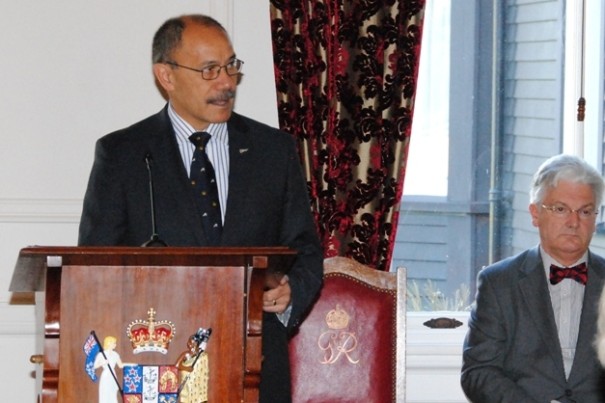Forum on Māori youth suicide

To view images of the forum, click here
E kui mā, e koro mā, tēnā koutou katoa. Nau mai, haere mai ki Te Whare Kawana o Te Whanganui-a-Tara. Na reira ki a ora tātou katoa. Ladies and gentlemen, greetings to you all and welcome to Government House.
I specifically acknowledge: Hon Peter Dunne, and Hon Tariana Turia, Associate Ministers of Health.
Thank you all for responding to my invitation to attend this forum at Government House on suicide prevention, with its particular focus on young Māori.
Suicide is one of the most perplexing of issues. The statistics surrounding suicides and intentional self-harm in New Zealand, being among the highest in OECD countries, are appalling. The more than 500 suicides committed by New Zealanders each year are so heart-breaking. These are statistics that should mortify all New Zealanders.
The collective grief suicide generates for family and friends, bereft at the loss of a loved one or respected colleague, is impossible to quantify. Many struggle with the questions of “why” and “what if,” unable to find any sense of understanding or resolution.
Suicide occurs across age and social groups and across all occupations, races and ethnicities. However, research indicates some New Zealanders are overly represented. They include men, those living in rural areas, young people and Māori. This means that the impact reaches deep into our communities and our personal lives.
While suicide rates in New Zealand have declined from their peak in the 1990s, every death is a death too many. And because each death is preventable, it behoves us to do all we can to help those at risk.
And yet while the desire to help is strong, there is no simple answer to addressing suicide. The matter was well summarised by the World Health Organisation, in a resource for media professionals, where it noted:
“As a serious public health problem it demands our attention, but its prevention and control, unfortunately, are no easy task. State-of-the-art research indicates that the prevention of suicide, while feasible, involves a whole series of activities, ranging from the provision of the best possible conditions for bringing up our children and youth, through to the effective treatment of mental disorders, to the environmental control of risk factors. Appropriate dissemination of information and awareness-raising are essential elements in the success of suicide prevention programmes.”
The question you may now have on the tip of your tongue is “so what?” The French philosopher Albert Camus once described suicide as the only question in philosophy that really mattered. I am not a philosopher. As those who know me can attest, I prefer to be a “do-er” rather than a talker.
I offered to host this forum because it is an issue we must give our best efforts to. Our young people, our rangatahi, are our nation’s greatest taonga. It is they who will inherit this land. It is our responsibility to ensure they are there to do that.
When Mr Dunne indicated to me some time ago that the Government would be launching its 2013-16 prevention strategy in May, I offered to host this forum to support the work he and Mrs Turia are doing. I felt that their efforts are an honest attempt to do something good.
Based on a vision of a society where all people feel they are valued and nurtured, value their own life, are supported and strengthened if they experience difficulties, and do not want to take their own lives or harm others, the strategy broadly outlines a number of initiatives that build on previous work. In reading it, two things become clear. The first is that its implementation depends on people in different agencies and organisations working together to make things happen. The issue is simply too important for parochial views and, or patch protection.
The second is that the strategy is just that – words on paper. Words are like the wind and turning them into action relies on the endeavour, support and goodwill of many people. “They” are people like you all sitting before me today. You are an interesting mix of health-practitioners, academics, social service providers, bureaucrats, and community workers. If I personalise it, there are parents, grandparents, uncles, aunts, sisters, brothers, friends and the loved-ones of people who may be “at risk”. Yet you are all authorities in this field, united by your knowledge, your ideas, your contacts and most of all your passion – that is what will give life to this strategy. Its implementation needs to be multi-faceted. One size does not fit all. Initiatives aimed at addressing suicide among those living in rural areas will not be the same as those aimed at young Māori in cities.
So it is in the spirit of a commitment to action that I welcome you all to Government House today. I wish you well with your discussions and look forward to hearing more at the conclusion of this hui.
The challenge you face is difficult. Some might say it is insurmountable. There are responses, some answers, but there are no simple fixes. In closing my remarks, I offer a proverb, some wisdom to guide your deliberations:
“Mā te ronga, ka mōhio; Mā te mōhio, ka mārama; Mā te mārama, ka mātau; Mā te mātau, ka ora – Through listening comes awareness; through awareness comes understanding; through understanding comes knowledge; through knowledge comes life and well-being.”
Kia ora, kia kaha, kia manawanui, huihui tātou katoa – be well, be strong, be courageous.
Helplines:
Lifeline: 0800 543 354 - Provides 24 hour telephone counselling
Youthline: 0800 376 633 or free text 234 - Provides 24 hour telephone and text counselling services for young people
Samaritans: 0800 726 666 - Provides 24 hour telephone counselling
Tautoko: 0508 828 865 - provides support, information and resources to people at risk of suicide, and their family, whanau and friends
Whatsup: 0800 942 8787 (noon to midnight)
Kidsline: 0800 543 754 (4pm - 6pm weekdays)
